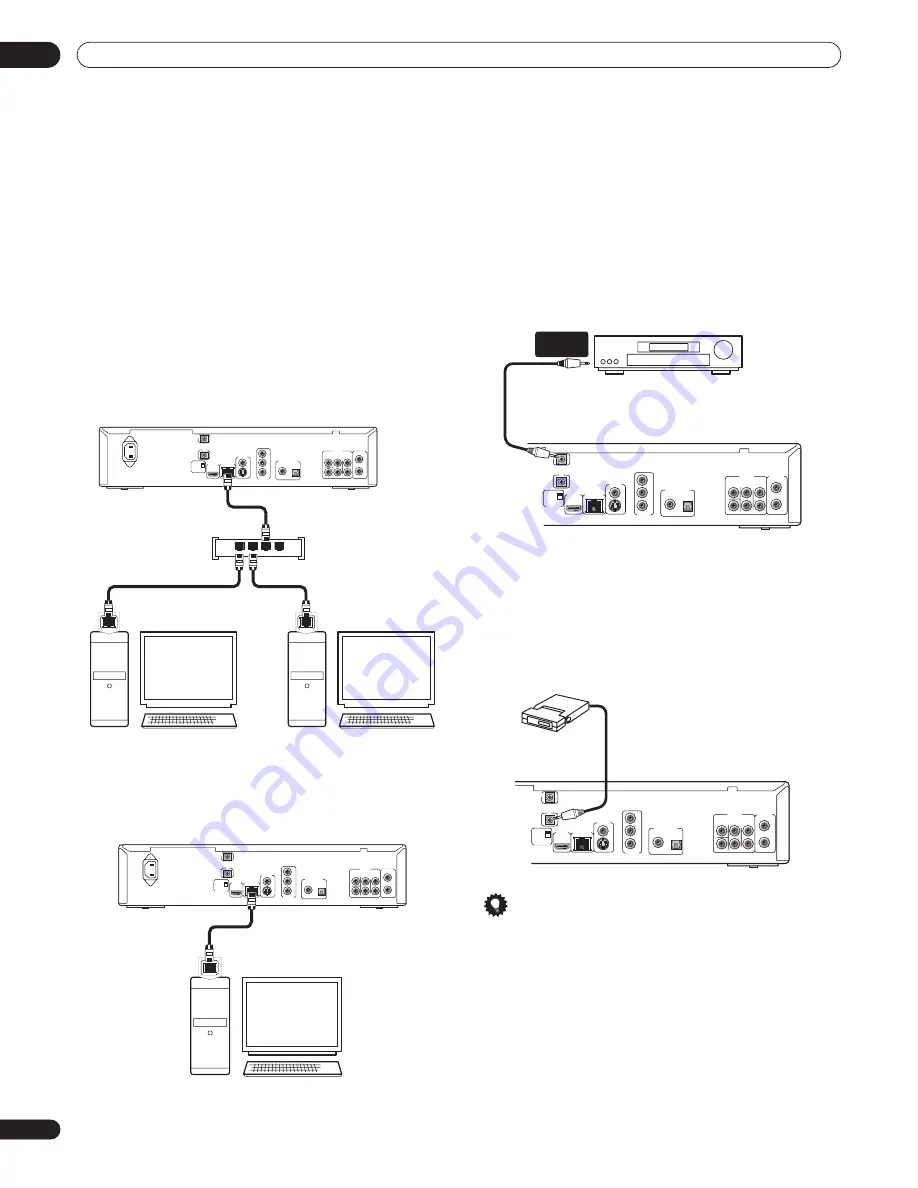
Connecting up
02
16
En
Network connection
This player can be connected to a local area network (LAN) via the
Ethernet port on the rear panel.
After making the physical connection the player needs to be set up
for network communication. This is done from the Initial Setup
menu—see
Setting up for network use
on page 21 for detailed
instructions.
For best performance, we recommend using a 100BASE-TX
compatible PC and Ethernet hub.
Connecting via an Ethernet hub
If you already operate one or more PCs on a local area network, you
can integrate this player by connecting it to the Ethernet hub using
a standard (also known as “straight through”) type CAT-5 LAN
(Ethernet) cable (not supplied).
In the example configuration below, this player would be able to
access content from either of the PCs.
Connecting directly to a PC
If you only need to use one PC to act as a media server, you can
connect this player directly to the PC using a crossed (also known
as a “cross-over”) type CAT-5 LAN (Ethernet) cable (not supplied).
Controlling this player via another
Pioneer component
The
CONTROL IN
jack allows you to control this player via the
remote control sensor of another Pioneer component—typically an
AV receiver—that has a
CONTROL OUT
jack. Remote control
signals are passed through to the player from the remote sensor of
the other component, allowing you greater freedom in the
placement of your player.
•
Use a miniplug cord (not supplied) to connect the CONTROL
IN jack of this player with the CONTROL OUT jack of your other
Pioneer component.
Using an external IR receiver with this
player
If you prefer to keep your AV equipment in a closed cabinet, you can
use an external IR receiver (such as a Niles or Xantech unit)
connected to the
IR IN
jack. You can thus have just the receiver
outside of the cabinet and still be able to control the player.
Tip
• You may need to set the
IR RECEIVER
switch (located under the
IR IN
jack) for this player to recognize the IR receiver correctly.
• This player does not supply power to the external IR receiver.
Please see the operating instructions of the IR receiver for the
power requirements.
AUDIO OUT
(5.1ch)
DIGITAL AUDIO OUT
AUDIO OUT
(2ch)
CENTER
SUB WOOFER
FRONT
SURROUND
L
L
R
R
COAXIAL
OPTICAL
COMPONENT
VIDEO OUT
VIDEO OUT
LAN(10/100)
HDMI OUT
Y
S
P
B
P
R
SETTING 2
SETTING 1
IR RECEIVER
IR
CONTROL
IN
IN
AC IN
LAN(10/100)
PC 1
PC 2
Ethernet hub
(router with hub functionality)
LAN(10/100)
1
2
3
4
AUDIO OUT
(5.1ch)
DIGITAL AUDIO OUT
AUDIO OUT
(2ch)
CENTER
SUB WOOFER
FRONT
SURROUND
L
L
R
R
COAXIAL
OPTICAL
COMPONENT
VIDEO OUT
VIDEO OUT
LAN(10/100)
HDMI OUT
Y
S
P
B
P
R
SETTING 2
SETTING 1
IR RECEIVER
IR
CONTROL
IN
IN
AC IN
LAN(10/100)
PC
AUDIO OUT
(5.1ch)
DIGITAL AUDIO OUT
AUDIO OUT
(2ch)
CENTER
SUB WOOFER
FRONT
SURROUND
L
L
R
R
COAXIAL
OPTICAL
COMPONENT
VIDEO OUT
VIDEO OUT
LAN(10/100)
HDMI OUT
Y
S
P
B
P
R
SETTING 2
SETTING 1
IR RECEIVER
IR
CONTROL
IN
IN
CONTROL
OUT
AV receiver
AUDIO OUT
(5.1ch)
DIGITAL AUDIO OUT
AUDIO OUT
(2ch)
CENTER
SUB WOOFER
FRONT
SURROUND
L
L
R
R
COAXIAL
OPTICAL
COMPONENT
VIDEO OUT
VIDEO OUT
LAN(10/100)
HDMI OUT
Y
S
P
B
P
R
SETTING 2
SETTING 1
IR RECEIVER
IR
CONTROL
IN
IN
IR receiver
















































